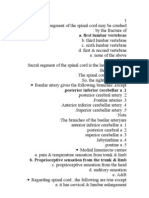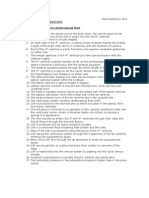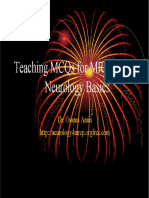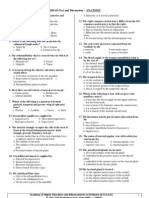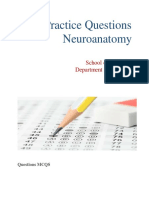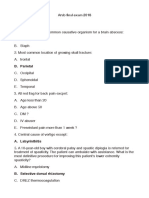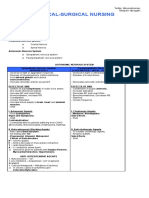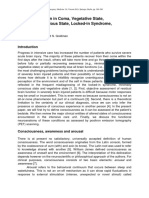II. MCQs Neuro
II. MCQs Neuro
Uploaded by
Mhmd IrakyCopyright:
Available Formats
II. MCQs Neuro
II. MCQs Neuro
Uploaded by
Mhmd IrakyCopyright
Available Formats
Share this document
Did you find this document useful?
Is this content inappropriate?
Copyright:
Available Formats
II. MCQs Neuro
II. MCQs Neuro
Uploaded by
Mhmd IrakyCopyright:
Available Formats
II. Answer the following by the most appropriate statement: 1. The ..is the cortical center for hearing.
a. paracentral lobule b. lingual gyrus c. cuneus d. brochas area e. Heshls gyrus 2. The auditory radiation passes in the ..of the internal capsule. a. anterior limb b. genu c. posterior limb d. sublenticular part e. retrolenticular part 3. The . is the thalamic center for hearing. a. superior colliculus b. inferior colliculus c. subthalamus d. medial geniculate body e. lateral geniculate body 4. The .is the reflex center of hearing. a. lateral geniculate body b. medial geniculate body c. dentate nucleus d. superior colliculus e. inferior colliculus 5. Drooping of eyelid is called: a. mydriasis b. squint d. anhydrosis c. ptosis e. non of above
6. Drooping of the upper eyelid results from paralysis of the ..cranial nerve. a. 2nd b. 3rd c. 4th d. 6th e. 7th 7. Closure of the eye by...cranial nerve. a. 5th b. 7th c. 6th d. all of the above e. non of above
8. The opening the eye by the ..cranial nerve. a. 3rd b. 4th c. 6th d. 7th e. non 9. The superior salivary nucleus belongs to the cranial nerve. a. 3rd b. 4th c. 5th d. 6th e. 7th 10. The trigeminal nerve is more important as a ...than.. a. parasympathetic..sympathetic. b. sympathetic.parasympathetic. c. sensory.motor. d. motorsensory. e. visceral...somatic.
13
11. The sensory area for taste lies in the .of cerebral cortex. a. upper part of postcentral gyrus b. paracentral lobule c. intermingled with sensory area of the face d. precuneus e. posterior part of superior frontal convolution 12. The ..nerve carry taste sensation: a. chorda tympani b. 9th cranial c. 10th cranial d. all of above e. only two of above 13. A lesion of the facial nerve may result in: a. dripping of saliva from the corner of mouth b. difficulty of whistling c. difficulty in opening the eyes d. cheek may puff out in respiration e. all of the above 14. The 7th cranial nerve is important because it supplies: a. taste to the anterior 2/3 of tongue b. lacrimal gland c. submandibular and sublingual salivary glands d. muscles of the face e. stapedius muscle 15. Difficulty to produce vocal sounds is called: a. dysarthria b. dysphonia c. dysphagia d. hoarseness of voice e. non of the above 16. The cranial nerve is responsible for hearing and equilibrium: a. 5th b. 6th c. 7th d. 8th e. 9th 17. The..cranial nerve supplies muscles of the tongue: a. 9th b. 10th c. 11th d. 12th e. non of above 18. The cranial nerves are purely sensory: a. 1st, 2nd and 9th b. 1st, 2nd and 5th c. 1st , 2nd and 8th. d. 2nd , . 5th. and 8 e. non of the above 19. Equilibrium impulses are carried by thecranial nerve. a. 1st b. 5th c. 7th d. 10th e. 8th
14
20. The ..cranial nerves are motor to the eye: a. 1st and 2nd b. 3rd and 4th c. 6th d. all of above e. b and c only 21. The ..cranial nerve is not a true peripheral nerve: a. 3rd b. 4th c. 7th d. 10th e. non of above 22. The only sensation which enters directly to the cerebral cortex without stopping in the thalamus is carried by the.cranial nerve. a. 1st b. 4th c. 7th d. 10th e. non of above 23. The .fibres supplies the smooth muscles: a. general somatic motor b. special somatic motor c. special visceral motor d. general visceral motor e. non of above 24. The sensation which arise from the skin are considered a. general visceral b. general somatic c. special somatic d. special visceral e. proprioceptive 25. Proprioceptive somatic sensation arises from: a. viscera b. skin. c. smooth muscles d. striated muscles e. mucous membrane 26. Special somatic sensations arise from: a. skin b. mucous membrane c. eye d. all of above e. non of above 27. Special visceral sensations arise from: a. eye b. ear c. taste buds d. all of above e. non of above
15
28. Motor order to the muscles of the face areefferent. a. general visceral b. special visceral c. general somatic d. special somatic e. non of above 29. Motor order to the striated muscles are.efferent. a. general visceral b. special visceral c. general somatic d. special somatic e. non of above 30. Sensation of smell aresensation: a. general visceral b. special visceral c. general somatic d. special somatic e. non of above 31. Sensation which arise from the taste buds are.sensation: a. general visceral b. general somatic c. special somatic d. special visceral e. non of above 32. The spinal cord is about..cm long. a. 25 b. 30 c. 35 d. 40 e. more than 40
33. The spinal cord is aboutcm shorter than the vertebral column. a. 5 b. 10 c. 15 d. 20 e. 25 34. The lower end of the spinal cord is called: a. cauda equine b. denticulate ligament c. conus medullaris d. ganglion impar e. non of above 35. The spinal cord ends at the level of the intervertebral disc between: a. T12 and L1 b. L1 and L2 c. L2 and L3 d. L3 and L4 e. non of above 36. Concerning the spinal cord, select the wrong statement: a. the filum terminale is attached to the back of the coccyx. b. the denticulate ligaments are attached to the dura mater. c. the dura mater is attached to the foramen magnum. d. all of the above are correct. e. non of above is correct.
16
37. Concerning the spinal dura mater, select the incorrect statement: a. forms a strong sheath around the spinal cord. b. consists of 2 layers. c. is adherent to the skull at foramen magnum. d. sends tubular sheath for the spinal nerves. e. ends below at the 2nd sacral vertebra. 38. Concerning the pia mater, select the incorrect statement: a. is a delicate and highly vascular layer of connective tissue. b. gives rise to denticulate ligaments. c. extends into the fissures and sulci. d. continues after the end of the spinal cord as filum terminale. e. is a boundary of the epidural space of the vertebral canal. 39. Hemisection of the spinal cord leads to, select the incorrect statement a. ipsilateral lower motor neuron paralysis at the segment of the lesion. b. contralateral upper motor neuron paralysis at the segment of the lesion. c. ipsilateral zone of cutaneous anesthesia at the segment of the lesion. d. ipsilateral loss of proprioception below the level of the lesion. e. contralateral loss of pain and temperature below the lesion. 40. The spinal cord is supported by, select the wrong statement: a. the filum terminale. b. the conus medullaris. c. the denticulate ligaments. d. the dura mater. e. the spinal nerve roots. 41. In cases of syringomyelia, select the wrong statement: a. is a degenerative disease. b. is characterized by narrowing of the central canal of the spinal cord. c. affects mainly the lower cervical and upper thoracic regions. d. causes damage of both lateral spinothalamic tracts. e. leads to loss of pain and temperature sensation in the affected segments. 42. Concerning the general features of the medulla oblongata, select the incorrect statement: a. it extends from foramen magnum to the lower border of the pons. b. it rests anteriorly upon the clivus. c. its lower half is opened to form the fourth ventricle. d. the roots of hypoglossal nerve emerge from the anterolateral sulcus. e. 9th, 10th and 11th cranial nerve emerge from the posterolateral sulcus. 43. Concerning the olive, select the incorrect statement: a. lies on the lateral surface of medulla oblongata. b. lies between the anterolateral and posterolateral fissures. c. is related anteriorly to the rootlets of hypoglossal nerve. d. is related posteriorly to the rootlets of 9, 10 and 11 cranial nerves. e. is produced by the superior olivary nucleus. 44. Concerning the general features of the pons, select the incorrect statement: a. lies above medulla oblongata. b. is about 3 cm long an 5 cm wide. c. its ventral surface is concave. d. has a ventral sulcus for the basilar artery. e. 7th and 8th cranial nerves emerge at its junction with the cerebellum.
17
45. Concerning the general features of the midbrain, select the incorrect statement: a. formed of 2 cerebral peduncles ventrally and tectum dorsally. b. its aqueduct passes through it. c. its aqueduct connects the 3rd and 4th ventricles. d. the tectum comprises 2 pairs of colliculi. e. oculomotor nerve emerges from the medial side of each peduncle. 46. The following are parts of the diencephalon, except: a. thalamus b. hypothalamus c. subthalamus d. corpus striatum e. pineal body 47. Concerning the thalamus, select the incorrect statement: a. all sensations stop in it before passing to cerebral cortex. b. shares in boundaries of the lateral ventricle. b. shares in boundaries of the third ventricle. c. shares in boundaries of the interventricular foramen of Monro. e. belongs to diencephalon. 48. Concerning the third ventricle, select the incorrect statement: a. communicates with the 4th ventricle through the cerebral aqueduct. b. the corpus callosum is a direct superior relation. c. has a recess related to the optic chiasma. d. is bounded anteriorly by the lamina terminalis. e. is related inferiorly to the posterior perforated substance. 49. Concerning recesses of the third ventricle, select the incorrect statement: a. optic recess b. infundibular recess c. pineal recess d. suprapineal recess e. lateral recess 50. Concerning the cerebellum, select the incorrect statement: a. it is found in the posterior cranial fossa. b. it is a part of brainstem. c. it is separated from the occipital lobes by tentorium cerebelli. d. it has two hemispheres. e. it is responsible for coordination. 51. Concerning the cerebellum, select the incorrect statement: a. it is formed of two hemispheres and median part the vermis. b. it shares in the formation of the fourth ventricle. c. it lies in the posterior cranial fossa. d. it has three peduncles connecting it to the midbrain. e. its largest nucleus is the dentate nucleus. 52. The functions of the cerebellum, select the incorrect statement: a. programming of rapid, skilled voluntary movements. b. integration of proprioception with reflex activity. c. coordination of somatic motor activity. d. regulation of muscle tone. e. tactile sense appreciation.
18
53. Ataxia results from, select the incorrect statement: a. damage of ventral horn motor neurons. b. damage of lateral horn cells. c. damage of the ventral roots. d. cerebellar damage. e. damage of the corticospinal tracts. 54. Concerning the 4th ventricle, select the incorrect statement: a. closed medulla oblongata shares in its floor. b. is roofed by the superior and inferior medullary vela. c. communicates with the 3rd ventricle through aqueduct of Sylvius. d. communicates with the subarachenoid space through one median and 2 lateral foramina. e. is bounded by the superior and inferior cerebellar peduncles respectively. 55. Concerning arterial circle of Willis, select the incorrect statement: a. occupies the interpeduncular fossa. b. is an anastomosis between the vertebrobasilar and internal carotid systems. c. has one anterior communicating and two posterior communicating arteries. d. is bathed in the cisterna interpeduncularis. e. the posterior communicating artery connects the posterior and the anterior cereberal arteries 56. The internal carotid artery, select the incorrect statement: a. enters the cranial cavity through the foramen lacerum. b. passes through the cavernous sinus. c. deos not share in the circle of Willis. d. related to the abducent nerve in the cavernous sinus. e. gives the ophthalmic branch to the eye. 57. The middle cerebral artery supplies the following except: a. somatomotor areas b. premotor area c. motor eye field d. primary visual area e. auditory area 58. Concerning the cerebrospinal fluid, select the incorrect statement: a. is produced by choroids plexuses of the ventricles mainly that of the lateral ventricles. b. the fluid passes through the interventricular foramina to the 4 th ventricle. c. the 4th ventricle has its own choroids plexus. d. leaves the ventricles to the subarachnoid space. e. is absorbed into the superior sagittal sinus via arachnoid villi and granulations. 59. Concerning the lateral ventricle, select the incorrect statement: a. is the ventricle of the cerebral hemisphere. b. each one is nearly C-shaped. c. is the main ventricle responsible for CSF production. d. each one is formed of two horns and body. e. each one communicates with the third ventricle. 60. Concerning the central sulcus, select the incorrect statement: a. separates the frontal lobe from the parietal lobe. b. separates the motor cortex from the sensory cortex. c. extends into the paracentral lobule. d. is located on the superolateral surface of the cerebral hemisphere. e. joins the lateral sulcus.
19
61. Concerning the lateral sulcus, select the incorrect statement: a, the posterior cerebral artery runs most of its course through it. b. is the deepest sulcus in the brain. c. has three rami, 2 anterior and 1 posterior. d. its posterior ramus separates the temporal lobe from the frontal and parietal lobes. e. the insula lies in its depth. 62. Concerning general features of corpus callosum, select the incorrect statement: a. is the largest commissure of the brain. b. consists principally of longitudinal fibers. c. consists of rostrum, genu, body, and splenium. d. its upper surface is related to falx cerebri. e. inferior surface is related to lateral ventricle. 63. Concerning the insula, select the incorrect statement: a. is a conical mass of grey mater lying in the depth of the lateral sulcus. b. is surrounded by a circular sulcus. c. its apex is referred to as the pulvinar. d. its anterior part has 3-4 short gyri. e. its posterior part has 1-2 long gyri. 64. The cerebral hemisphere contains, select the incorrect statement: a. caudate nucleus b. amygdaloid body c. lentiform nucleus d. claustrum e. globose nucleus 65. The frontal lobe contains, select the incorrect statement: a. Wernickes speech area b. Brocas speech area c. precentral gyrus d. motor area (area 4) e. the center controlling eye movements 66. The sensory areas of the cerebral cortex include, select the incorrect statement: a. visual area b. auditory area c. olfactory area d. somatosensory area e. thermal area 67. The commissures of the brain are, select the incorrect statement: a. corpus callosum b. corpus striatum c. forceps minor d. forceps major e. hippocampal commissure (commissure of fornix) 68. Part of the corpus callosum, select the incorrect statement: a. forceps minor b. tapetum c. cingulum d. forceps major e. splenium
20
69. The association fibers are the following except: a. uncinate fasiculus b. cingulum c. corona radiate d. superior longitudinal bundle e. inferior longitudinal bundle 70. The central nervous system, select the incorrect statement: a. is protected by bones. b. is protected by meninges. c. is covered directly by the arachnoid mater. d. receives different sensation. e. associate and integrates different sensation. 71. Concerning the meninges, select the incorrect statement: a. the dura mater is the most delicate of the three. b. the pia mater is the nearest membrane to the C.N.S. c. the arachnoid mater lies between the pia and dura mater. d. they cover both the brain and spinal cord. e. they contain spaces between them. 72. Each cerebral hemisphere consists of, select the incorrect statement: a. white matter b. lateral ventricle c. cerebral cortex d. basal ganglia e. brain stem 73. The brain stem consists of the following, except: a. choroids plexus b. basal ganglia c. midbrain d. pons e. medulla oblongata 74. Parts of the cerebellum are, except: a. nuclei b. vermis d. cortex c. Hemispheres e. lateral ventricle
75. Concerning the ventricles, select the incorrect statement: a. the third ventricle is the cavity of the diencephalons. b. the lateral ventricle is the cavity of the cerebral hemisphere. c. the fourth ventricle is the cavity of the hindbrain. d. the lateral ventricle consists of a body and two horns. e. the cerebral aqueduct connects the third and fourth ventricles. 76. Concerning the lateral ventricle, select the incorrect statement: a. its anterior horn lies in the frontal lobe. b. it is the only cavity in the brain. c. its posterior horn lies in the occipital lobe. d. its inferior horn lies in the temporal lobe. e. it has a choroids plexus.
21
77. Concerning the cerebrospinal fluid, select the incorrect statement: a. its average amount is 135 c.c. b. circulates in the subdural space. c. acts as a water cushion. d. absorbed via arachnoid granulations and villi. e. regulates the intracranial pressure. 78. Concerning the meninges, select the incorrect statement: a. the pia mater is the nearest membrane to the C.N.S. b. the arachnoid mater lies between the pia and dura mater. c. the dura mater is the most delicate of the three. d. they cover both the brain and spinal cord. e. they contain spaces between them. 79. Each cerebral hemisphere consists of the following except: a. white matter b. lateral ventricle c. cerebral cortex d. basal ganglia e. brain stem 80. Concerning the ventricles of the brain, select the incorrect statement: a. the lateral ventricle looks like the letter C. b. the third is the cavity of the diencephalons. c. the fourth is the cavity of the hind brain. d. the posterior horn of the lateral ventricle lies in the occipital lobe . e. the lateral is the cavity of the midbrain. 81. Concerning the fourth ventricle, select the incorrect ststement: a. its floor is formed by the medulla and pons. b. its roof is formed by the cerebellum. c. its roof is formed by the superior and inferior medullary vela. d. is connected above with the aqueduct of Sylvius. e. is the cavity of pons, medulla and mesencephalon. 82. Concerning the fourth ventricle, choose the false statement: a. is tent-shaped when seen from above. b. is diamond-shaped when seen from the side. c. has a roof, a floor and two medial walls. d. cerebral aqueduct open into it. e. its roof is formed by the superior and inferior medullary vela. 83. Contents of the interpeduncular fossa include, except; a. olfactory tract or bulb b. mamillary bodies c. tuber cinereum d. infundibulum e. posterior perforated substance 84. Concerning the circulus arteriosus, select the incorrect statement: a. lies in the interpeduncular fossa. b. consists of six large and small communicating arteries. c. there are 2 anterior and one posterior communicating arteries. d. the posterior cerebral artery is not a branch of the internal carotid artery. e. lies around the region of the hypothalamus.
22
85. Concerning the anterior cerebral artery, select the wrong answer: a. is the smaller branch of the internal carotid artery. b. runs backwards along the upper surface of the corpus callosum. c. ends by turning upwards anterior to the parietooccipital fissure. d. has cortical but no central branches. e. supplies all parts of the corpus callosum, except the splenium. 86. The anterior cerebral artery supplies the following except: a. the motor and sensory areas of the lower limb b. all of the paracentral lobule c. all of the septum lucidum d. all of the corpus callosum e. the medial half of the orbital surface of the cerebral hemisphere 87. The middle cerebral artery supplies the following except: a. splenium of corpus callosum b. insula c. main part of the lateral surface of the hemisphere d. lateral half of the orbital surface e. temporal pole 88. The middle cerebral artery supplies the following except: a. auditory area b. genu and posterior limb of internal capsule c. medial half of the orbital surface of the hemisphere d. motor and sensory area of the whole body e. insula 89. Concerning the cortical blood supply of the brain, choose the incorrect statement: a. the medial half of the orbital surface is supplied by the anterior cerebral artery. b. the lateral half of the orbital surface is supplied by the posterior cerebral artery. c. the temporal pole is supplied by the middle cerebral artery. d. the occipital lobe is supplied by the posterior cerebral artery. e. there are three cerebellar arteries on either side. 90. Concerning the blood supply of the brain, select the incorrect statement a. the basilar artery supplies the pons. b. the vertebral artery supplies the medulla oblongata. c. the posterior inferior cerebellar artery supplies the medulla. d. the posterior inferior cerebellar artery supplies the inferior surface of the cerebellum. e. there is one posterior and two anterior spinal arteries. 91. Concerning the cerebellum, all are true except: a. has two surfaces: upper and lower. b. has two notches: anterior and posterior. c. Has an anterior notch occupied by the falx cerebelli. d. has three peduncles. e. has a vermis which lies in the vallecula.
23
92. Concerning the insula, select the wrong statement: a. is crossed by the middle cerebral artery. b. is conical in shape. c. its base is directed downwards. d. it is covered by the opercula. e. is subdivided into 2 long and a number of small short sulci. 93. The projection fibers are the following except: a. corticothalamic b. optic radiation c. fornix d. frontopontine e. cingulum 94. The corpus callosum consists of the following except: a. splenium b. forceps minor d. anterior commissure e. tapetum 95. The corpus callosum connects the following except: a. both frontal poles b. both occipital poles c. both temporal poles d. both prefrontal regions e. both parietal association regions 96. Concerning the basal ganglia includes the following except: a. amygdaloid nucleus b. claustrum c. uncus d. caudate nucleus e. lentiform nucleus 97. Parts of the hypothalamus are except: a. optic chiasma b. infundibulum c. tuber cinereum d. anterior commissure e. mamillary bodies 98. The pyramidal tract lies in the of the internal capsule: a. anterior limb b. genu c. anterior of the posterior limb d. posterior of posterior limb. e. non of the above 99. ..% of the fibers of the pyramidal tract crosses in the pyramidal decussation. a. 40-50 b. 50-60 c. 60-70 d. 70-80 e. More than 80 c. forceps major
24
100. The corticobulbar fibers pass through theof the internal capsule: a. anterior limb b. genu c. posterior limb d. retrolenticular part e. sublenticular part II. The Answers of MCQs
1 2 3 4 5 6 7 8 9 10 11 12 13 14 15
e d d e c b b a e c c d e d b
1 6 1 7 1 8 1 9 2 0 2 1 2 2 2 3 2 4 2 5 2 6 2 7 2 8 2 9 3 0
d d c e e e a d b d c c b c b
3 1 3 2 3 3 3 4 3 5 3 6 3 7 3 8 3 8 4 0 4 1 4 2 4 3 4 4 4 5
d e e c b e b e b b b c e c c
4 6 4 7 4 8 4 9 5 0 5 1 5 2 5 3 5 4 5 5 5 6 5 7 5 8 5 9 6 0
e a b e b d e d a e c d b d e
6 1 6 2 6 3 6 4 6 5 6 6 6 7 6 8 6 9 7 0 7 1 7 2 7 3 7 4 7 5
a b c e a e b c c c a e a e d
7 6 7 7 7 8 7 9 8 0 8 1 8 2 8 3 8 4 8 5 8 6 8 7 8 8 8 9 9 0
b b c e e e c a c d d a c b e
91 92 93 94 95 96 97 98 99 10 0
c c e d c c d c e b
25
You might also like
- Neuroanatomy McqsDocument18 pagesNeuroanatomy Mcqskishorechandra85% (33)
- Neuroanatomy MCQDocument30 pagesNeuroanatomy MCQNishanthy Pirabakar90% (61)
- Neurology: Self-Assessment for MRCP(UK) Neurology SCEFrom EverandNeurology: Self-Assessment for MRCP(UK) Neurology SCERating: 5 out of 5 stars5/5 (1)
- Wilson - Cranial NervesDocument243 pagesWilson - Cranial NervesBiblioteca CSNT100% (20)
- Neurology Multiple Choice Questions With Explanations: Volume IIFrom EverandNeurology Multiple Choice Questions With Explanations: Volume IIRating: 5 out of 5 stars5/5 (2)
- Cns MCQ 1st TermDocument41 pagesCns MCQ 1st TermNaeem Amin75% (4)
- Cranial Nerves MCQDocument12 pagesCranial Nerves MCQViweka Sarangi100% (8)
- MCQ CNS AnatomyDocument7 pagesMCQ CNS AnatomyGroup 1491% (11)
- Neurology Multiple Choice Questions With Explanations: Volume IFrom EverandNeurology Multiple Choice Questions With Explanations: Volume IRating: 4 out of 5 stars4/5 (8)
- Internal Medicine Logbook ArabicDocument7 pagesInternal Medicine Logbook ArabicMhmd IrakyNo ratings yet
- Neuroanatomy McqsDocument20 pagesNeuroanatomy McqsNuman Khan0% (1)
- III. Mcqs NeuroDocument19 pagesIII. Mcqs NeuroMhmd Iraky100% (2)
- Multiple Choice QuestionsDocument7 pagesMultiple Choice QuestionsTARIQ100% (2)
- I MCQs Neuro.Document4 pagesI MCQs Neuro.Mhmd Iraky100% (1)
- NeuroanatomyDocument3 pagesNeuroanatomyModoro50% (2)
- 2011-2012 Group 6Document5 pages2011-2012 Group 6Law YouNo ratings yet
- Neurology MCQDocument5 pagesNeurology MCQRaghu Nadh0% (1)
- Neurosurgey MCQ Collection Part IDocument35 pagesNeurosurgey MCQ Collection Part IMohammed Ali Aldhahir90% (10)
- Brain and Cranial NervesDocument11 pagesBrain and Cranial NervesJhara100% (1)
- Anatomy Forearm MCQDocument2 pagesAnatomy Forearm MCQthevampire20104825100% (1)
- Final-Exam Neurosurgery - 2-VersionDocument6 pagesFinal-Exam Neurosurgery - 2-VersionMAMA LALA100% (2)
- I MCQs Neuro.Document4 pagesI MCQs Neuro.Mhmd Iraky100% (1)
- Orthopaedic Physiotherapy Assessment Chart For Physiotherapists by Dr. Krishna N. SharmaDocument7 pagesOrthopaedic Physiotherapy Assessment Chart For Physiotherapists by Dr. Krishna N. SharmaDr. Krishna N. Sharma86% (58)
- Brain and Cranial NervesDocument11 pagesBrain and Cranial NervesJhara100% (1)
- Fdocuments - in Neuroanatomy-McqsDocument28 pagesFdocuments - in Neuroanatomy-McqsRashee Goyal100% (1)
- IV. Mcqs NeuroDocument7 pagesIV. Mcqs NeuroMhmd Iraky100% (1)
- 25 MCQ NeuroDocument5 pages25 MCQ NeuroVaishnavi Singh100% (1)
- NeuroanatomyDocument7 pagesNeuroanatomyEslam Almassri100% (1)
- Anatomy Cns MCQs 11Document9 pagesAnatomy Cns MCQs 11علي. احمد100% (2)
- Head and Neck McqsDocument3 pagesHead and Neck McqsRajitha DilhanNo ratings yet
- 100 Anatomy McqsDocument19 pages100 Anatomy McqsHiếu Kiều50% (2)
- Anatomy MCQ 1Document15 pagesAnatomy MCQ 1Maria75% (4)
- CNS Mcqs PDFDocument12 pagesCNS Mcqs PDFSindhi Waseem BalochNo ratings yet
- CNS MCQSDocument24 pagesCNS MCQSSTEVEN OKURUT100% (2)
- Neuro MCQDocument15 pagesNeuro MCQSushanta BhanjaNo ratings yet
- Cerebellum MCQ'S: A) Posterior LobeDocument2 pagesCerebellum MCQ'S: A) Posterior LobeTahir Aziz100% (2)
- Neurology MCQDocument6 pagesNeurology MCQMuhammad Qasum43% (7)
- Neuroanatomy MCQDocument7 pagesNeuroanatomy MCQi can always make u smile :D78% (9)
- Teaching MCQ-Neurology BasicsDocument17 pagesTeaching MCQ-Neurology Basicslonsilord17No ratings yet
- Tanta Neuro MCQDocument9 pagesTanta Neuro MCQBadr Diham100% (1)
- Fracp Past Papers - NeurologyDocument21 pagesFracp Past Papers - NeurologyLakshya J BasumataryNo ratings yet
- Neuroanatomy MCQDocument7 pagesNeuroanatomy MCQNishanthy Pirabakar0% (1)
- Neurology SAUDI EXAM 1Document19 pagesNeurology SAUDI EXAM 1Asif Newaz100% (2)
- Neurosurgery Past PapersDocument74 pagesNeurosurgery Past PapersRand Ahmad100% (1)
- Waxman - Neuroanatomy Self-Assessment MCQsDocument46 pagesWaxman - Neuroanatomy Self-Assessment MCQsNikunj94% (33)
- Neurology MCQDocument3 pagesNeurology MCQAlshare NisreenNo ratings yet
- Anatomy McqsDocument3 pagesAnatomy McqsJesna Jesna V100% (2)
- General Practitioner - Neurology MCQsDocument20 pagesGeneral Practitioner - Neurology MCQsAsif Newaz100% (3)
- Neuro MCQDocument4 pagesNeuro MCQLim EricNo ratings yet
- 100 Practice Questions Gross Anatomy Neurology Neuroanatomy MCQDocument68 pages100 Practice Questions Gross Anatomy Neurology Neuroanatomy MCQAdmin Duties100% (1)
- Question Chapter 4 Spinal Cord and Ascending, Descending, and Interegmental TractsDocument17 pagesQuestion Chapter 4 Spinal Cord and Ascending, Descending, and Interegmental TractsTrang BuiNo ratings yet
- MCQ NeurologyDocument18 pagesMCQ NeurologySAlemsa0% (1)
- NeuroanatomyDocument4 pagesNeuroanatomyLouis Fortunato100% (2)
- QB-Neurophysiology 1st MidtermDocument19 pagesQB-Neurophysiology 1st MidtermJUANA ELIZABETH LOZA CASTRONo ratings yet
- Head Neck McqsDocument22 pagesHead Neck McqsZllison Mae Teodoro Mangabat100% (2)
- Arab Board Final 2018 - 2Document12 pagesArab Board Final 2018 - 2lonsilord17No ratings yet
- Lower Limb MCQ FinalDocument7 pagesLower Limb MCQ FinalTofunmi AdegokeNo ratings yet
- Head Neck MCQ ChaptersDocument17 pagesHead Neck MCQ ChaptersMohamed GhabrunNo ratings yet
- Anatomy MCQ - Abdomen - 2Document15 pagesAnatomy MCQ - Abdomen - 2ahsan gujjarNo ratings yet
- Neurology Multiple Choice Questions With Explanations: Volume IIIFrom EverandNeurology Multiple Choice Questions With Explanations: Volume IIIRating: 4.5 out of 5 stars4.5/5 (6)
- Anatomy CAT QuestionsDocument7 pagesAnatomy CAT Questionsidokofavour2015No ratings yet
- Head and Neck Test QuestionsDocument63 pagesHead and Neck Test QuestionsAbouzr Mohammed Elsaid100% (4)
- IER's National Physical Therapy Examination Review & Study Guide2 PDFDocument17 pagesIER's National Physical Therapy Examination Review & Study Guide2 PDFMhmd Iraky0% (1)
- Balance Assessment and TreatmentDocument55 pagesBalance Assessment and TreatmentMhmd Iraky100% (1)
- ue 1-Broc s Are ʹ an area of the frontal lobe, usually in the left hemisphere, that directs the muscle movements involvedDocument31 pagesue 1-Broc s Are ʹ an area of the frontal lobe, usually in the left hemisphere, that directs the muscle movements involvedMhmd IrakyNo ratings yet
- Bio 200NDocument55 pagesBio 200NkathleenjanlosbanezNo ratings yet
- Case Study On Stroke: Tadikela Subbaiah College of Nursing Shimoga, KarnatakaDocument19 pagesCase Study On Stroke: Tadikela Subbaiah College of Nursing Shimoga, KarnatakaRashmi C S0% (1)
- PerDev Quarter 1 Module 6Document10 pagesPerDev Quarter 1 Module 6JonnelynNo ratings yet
- Regional Neuroanatomy (Presentation) Author Chris ThomsonDocument41 pagesRegional Neuroanatomy (Presentation) Author Chris Thomsonsari dianitaNo ratings yet
- Welcome To CSE/NEUBEH 528: Computational Neuroscience: Today's AgendaDocument27 pagesWelcome To CSE/NEUBEH 528: Computational Neuroscience: Today's AgendaEdward Kofi AzeleorNo ratings yet
- Cap 1 Sensory Integration Theory and PracticeDocument33 pagesCap 1 Sensory Integration Theory and PracticeLuz Dianeth ZapataNo ratings yet
- First Year M.B.B.S. Examination March / April - 2019 Anatomy Paper 1Document3 pagesFirst Year M.B.B.S. Examination March / April - 2019 Anatomy Paper 1Tushar RajNo ratings yet
- Ascending Tracts (Somatosensory Axis)Document94 pagesAscending Tracts (Somatosensory Axis)Gks100% (2)
- PerDev ReviewerDocument4 pagesPerDev ReviewerJaira PedritaNo ratings yet
- Nervous Part 2Document61 pagesNervous Part 2Josh Brenner100% (1)
- Chapter # 1 Assignment # 1.2: Human Organ Systems Human BrainDocument16 pagesChapter # 1 Assignment # 1.2: Human Organ Systems Human BrainOM PkNo ratings yet
- Neurological Examination PDFDocument6 pagesNeurological Examination PDFArif K BashaNo ratings yet
- Medical Surgical Nursing Review NotesDocument76 pagesMedical Surgical Nursing Review Notesnot your medz duranNo ratings yet
- Nervous System - NOTESDocument17 pagesNervous System - NOTESSharina Marie CoderaNo ratings yet
- 15 The Internal Structures of Brain StemDocument26 pages15 The Internal Structures of Brain StemCandilicious10100% (1)
- 9 The Human Brain and Photographs and DiagramsDocument2 pages9 The Human Brain and Photographs and DiagramsMaximiliano PortilloNo ratings yet
- Anatomy of TH Brain: BrainstemDocument2 pagesAnatomy of TH Brain: BrainstemHanna RamosNo ratings yet
- Edney 1986Document10 pagesEdney 1986Itai IzhakNo ratings yet
- RC Practice Questions by e GMAT PDFDocument28 pagesRC Practice Questions by e GMAT PDFSharmi RoyNo ratings yet
- Neurological ExamDocument40 pagesNeurological ExamfidaNo ratings yet
- Nervous System ReviewerDocument26 pagesNervous System ReviewerAllea Marie SabacNo ratings yet
- Chapter 8 - Nervous System RP PDFDocument105 pagesChapter 8 - Nervous System RP PDFpizzaNo ratings yet
- Lecture - Slides-01 - 06 - Medial Surface of The BrainDocument6 pagesLecture - Slides-01 - 06 - Medial Surface of The BrainMaria Eduarda VianaNo ratings yet
- BRT Anatomy - NeuroanatomyDocument6 pagesBRT Anatomy - NeuroanatomyNicole Santos100% (3)
- Anatomy OSPEDocument17 pagesAnatomy OSPEjulietchiminyaNo ratings yet
- Disorders of The Brainstem and Cranial Nerves SY 2022-2023Document141 pagesDisorders of The Brainstem and Cranial Nerves SY 2022-2023Geraldine Teopy100% (1)
- The Nervous SystemDocument8 pagesThe Nervous SystemKristiene Kyle AquinoNo ratings yet
- WWW Anime7 DownloadDocument11 pagesWWW Anime7 DownloadGomedi WuNo ratings yet








